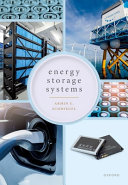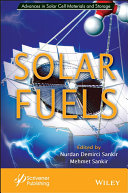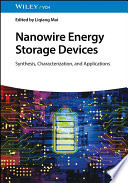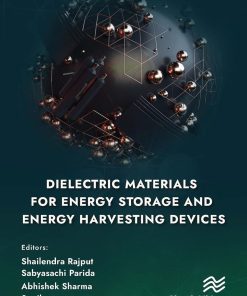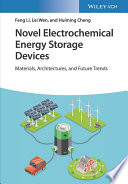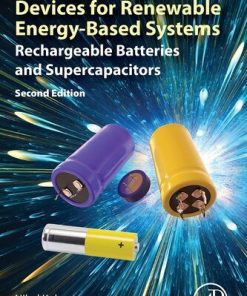(EBook PDF) Advances in Supercapacitor and Supercapattery Innovations in Energy Storage Devices 1st edition by Mohammad Khalid, Numan Arshid, Nirmala Grace 0128204036 9780128204030 full chapters
$50.00 Original price was: $50.00.$25.00Current price is: $25.00.
Advances in Supercapacitor and Supercapattery: Innovations in Energy Storage Devices 1st edition by Mohammad Khalid, Numan Arshid, Nirmala Grace – Ebook PDF Instant Download/DeliveryISBN: 0128204036, 9780128204030
Full download Advances in Supercapacitor and Supercapattery: Innovations in Energy Storage Devices 1st edition after payment

Product details:
ISBN-10 : 0128204036
ISBN-13 : 9780128204030
Author: Mohammad Khalid, Numan Arshid, Nirmala Grace
Advances in Supercapacitor and Supercapattery: Innovations in Energy Storage Devices provides a deep insight into energy storage systems and their applications. The first two chapters cover the detailed background, fundamental charge storage mechanism and the various types of supercapacitor. The third chapter give details about the hybrid device (Supercapattery) which comprises of battery and capacitive electrode. The main advantages of Supercapattery over batteries and supercapacitor are discussed in this chapter. The preceding three chapters cover the electrode materials used for supercapattery. The electrolyte is a major part that significantly contributes to the performance of the device. Therefore, different kinds of electrolytes and their suitability are discussed in chapter 6 and 7. The book concludes with a look at the potential applications of supercapattery, challenges and future prospective. This book is beneficial for research scientists, engineers and students who are interested in the latest developments and fundamentals of energy storage mechanism and clarifies the misleading concepts in this field.
Advances in Supercapacitor and Supercapattery: Innovations in Energy Storage Devices 1st Table of contents:
1. Chapter one. Background of energy storage
1.1 Introduction
1.2 Importance of energy storage
1.3 Batteries and capacitors
1.4 Fundamentals of energy storage
1.5 Electrochemical energy storage systems and materials
1.6 Status of energy storage technology development
1.7 Challenges and prospects of energy storage technologies
1.8 Energy storage systems costs and values
1.9 Technology frontiers
1.10 Conclusion
References
Chapter two. Fundamental electrochemical energy storage systems
Abstract
2.1 Introduction
2.2 Background of energy storage
2.3 Electrochemical capacitors
2.4 Principle of energy storage in electrochemical capacitors
2.5 Charge storage mechanism in electrical dual layer condensers
2.6 Electrical double-layer capacitor
2.7 Pseudocapacitor
2.8 Types of pseudocapacitance
2.9 Conclusion
References
Chapter three. Introduction to supercapattery
Abstract
3.1 Introduction
3.2 Charge storage mechanism in electrochemical energy storage systems
3.3 Difference between pseudocapacitive and battery-grade materials
3.4 Conclusions
References
Chapter four. Conducting polymeric nanocomposite for supercapattery
Abstract
4.1 Introduction to conducting polymers
4.2 Types of C-polymers
4.3 Problems related to conducting polymers based electrodes
4.4 Polymer nanocomposite
4.5 Nanocomposites of conducting polymer with various nanomaterials
4.6 Conclusion
4.7 Abbreviations
References
Chapter five. Carbonaceous nanocomposites for supercapattery
Abstract
5.1 Introduction
5.2 Carbonaceous electrode materials
5.3 Summary and outlook
References
Chapter six. Binary metal oxides for supercapattery devices
Abstract
6.1 Introduction
6.2 Binary metal oxides
6.3 Summary and future outlook
References
Chapter seven. Ternary nanocomposites for supercapattery
Abstract
7.1 Introduction
7.2 Noble metals
7.3 Metal oxides
7.4 Carbonaceous materials
7.5 Conducting polymers
7.6 Conclusions and future work
Acknowledgments
References
Chapter eight. Metal/metal oxide thin film electrodes for supercapatteries
Abstract
8.1 Hybrid supercapacitors or supercapatteries
8.2 Metal oxides as electrode materials
8.3 Performance of metal oxide electrodes
8.4 Hybridization of metal oxides
8.5 Summary
References
Chapter nine. Layered double hydroxide as electrode material for high-performance supercapattery
Abstract
9.1 Introduction
9.2 Energy storage mechanism
9.3 Synthesis of layered double hydroxides nanostructures
9.4 Transition metal layered double hydroxides for supercapattery
9.5 Core–shell layered double hydroxides
9.6 Carbon material/layered double hydroxide composites for supercapattery
9.7 Summary
Acknowledgments
References
Chapter ten. MXene
Abstract
10.1 MXene
10.2 Structure and types of MXene
10.3 MXene in supercapacitors
10.4 MXene in rechargeable batteries
10.5 MXene in supercapattery
10.6 Conclusion
References
Chapter eleven. Aqueous solid and gel electrolytes for supercapattery
Abstract
11.1 Introduction
11.2 Polymer electrolytes
11.3 Conclusion and future challenges
Acknowledgments
References
Chapter twelve. Applications of supercapattery
Abstract
12.1 Introduction
12.2 Metal oxide/metal hydroxide–based supercabattery
12.3 Chalcogenides supercabatteries
12.4 Importance of supercabattery commercialization and applications
12.5 Conclusion
References
Chapter thirteen. Supercapattery: technical challenges and future prospects
Abstract
13.1 Introduction
13.2 Technical challenges
13.3 Prospects
13.4 Market potential
13.5 Conclusion
People also search for Advances in Supercapacitor and Supercapattery: Innovations in Energy Storage Devices 1st:
supercapacitor advantages and disadvantages
disadvantages of supercapacitor
applications of supercapacitor
review on supercapacitors
supercapacitors in series
Tags:
Advances,Supercapacitor,Supercapattery,Innovations,Energy Storage Devices,Mohammad Khalid,Numan Arshid,Nirmala Grace
You may also like…
Technique - Energy: Renewable Energy
Energy Storage Systems: System Design and Storage Technologies 1st Edition
Technique - Energy: Renewable Energy
Solar Fuels (Advances in Solar Cell Materials and Storage) 1st Edition Nurdan Demirci Sankir
Engineering - Industrial Engineering & Materials Science
Engineering - Energy & Power Resources
Dielectric Materials for Energy Storage and Energy Harvesting Devices 1st Edition
Technique - Energy
Emerging Carbon Capture Technologies: Towards a Sustainable Future 1st Edition Mohammad Khalid
Technique - Energy: Renewable Energy






